Soil/Landform Unit 160
Landform Unit Description
Page top
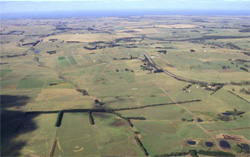 The undulating coastal plains of the south-west coast that are used for dairy farming |
0.55% of CMA region Rolling dissected hills of the southern Heytesbury region are formed from Miocene marine clay, marl and limestone, and Recent clay sand and gravel. This stretch of rolling hills extends from Newfield to Princetown. Slumping of the landscape has led to occasional steep scarps, but most slopes are long, gentle and straight, separated by broad drainage lines. Significantly this unit varies from soil-landform unit 165 due to the occurrence of residual near level crests with cappings of Neogene sediments within this unit. Soils on these Miocene sediments are typically brown, grey and black texture contrast soils, with heavier textured cracking clays lower in the landscape. Free lime is often present at depth in the soil profile. Soils on these sediments are significantly more fertile than the soils formed on the Neogene sediments of the crests. These soils tend to be weakly structured. Profile drainage is good on all but those areas with hardpans. Nearly all native vegetation has been cleared as part of the soldier settlement. Dairy farming is the main land use. Subsoils are dispersible and gully erosion has occurred along some drainage lines. Landslip and slumping is a major engineering issue that escalates when soils are waterlogged. Drainage lines and lower slopes remain waterlogged for most of the year and are prone to soil compaction (pugging) by stock. | 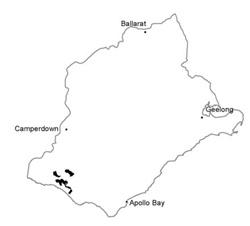 |
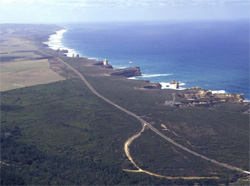 The 12 apostles and undulating coastal plains of the south-west coast | 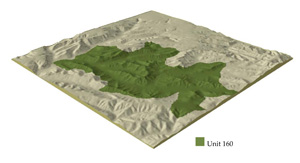 |
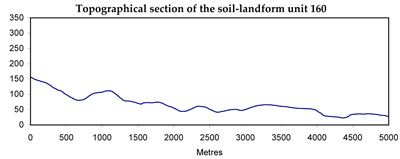 | 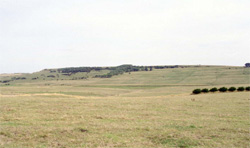 Limestone plateau north of Princetown |
Component | 1 | 2 | 3 | 4 | 5 |
Proportion of soil-landform unit | 17% | 5% | 45% | 25% | 8% |
| CLIMATE Rainfall (mm) | Annual: 900-1000, lowest January (40), highest August (120) | ||||
| Temperature (oC) | Annual: 14, lowest July (9), highest February (18) | ||||
| Seasonal growth limitations | Temperature: less than 10oC (av.) June-August Precipitation: less than potential evapotranspiration November-March | ||||
| GEOLOGY Age and lithology | Miocene marine marl and minor Recent clay, sand and gravel | ||||
| Geomorphology | |||||
| LANDUSE | Cleared areas: Dairy cattle, grazing beef cattle; sheet Minor uncleared areas: Nature conservation | ||||
| TOPOGRAPHY Landscape | Rolling dissected hills with remnant plain cappings | ||||
| Elevation range (m) | 3-174 | ||||
| Local relief (m) | 30-60 | ||||
| Drainage pattern | Parallel | ||||
| Drainage density (km/km2) | 3.3 | ||||
| Landform | Ridges | Fault scarps | Hillslopes | Drainage lines | |
| Landform element | Crests and upper slopes | - | Mid slope, crest | Lower slope | - |
| Slope and range (%) | 5 (2-9) | 29 (57-37) | 11 (4-21) | 4 (1-7) | 0 (0-1) |
| Slope shape | Convex | Concave | Convex | Concave | Linear |
| NATIVE VEGETATION Structure | Low woodland (variable) | Open forest | Woodland | Woodland | Closed scrub |
| Dominant species | E. nitida, E. baxteri | E. obliqua, E. baxteri, E. ovata, Acacia melanoxylon | E. ovata, E. radiata | E. obliqua, E. ovata | Melaleuca squarrosa, Leptospermum lanigerum |
| SOIL Parent material | Sand | Clay and silt; some lateritic remnants | Colluvial/alluvial marl and sand | Colluvial/alluvial marl and sand | Plant remnants, alluvial sand and clay |
| Description (Corangamite Soil Group) | Grey sand soils with hardpans (29) | Mottled brown, yellow and grey texture contrast soils, coarse to fine structure (20) | Mottled brown, yellow and grey texture contrast soils, coast to fine structure (20) | Grey gradational soils (22) | |
| Soil type sites | OTR608, OTR742 | OTR608, OTR785 | OTR733, CLRA10 | ||
| Surface texture | Loamy sand | Loamy sand to sandy loam | Sandy loam to clay | Sandy loam to clay | Silty loam |
| Permeability | Very low | Moderate | Very low | Very low | Low |
| Depth (m) | >2 | >2 | >2 | >2 | >2 |
| LAND CHARACTERISTICS, POTENTIAL AND LIMITATIONS | Weakly structured sands on hardpans are prone to sheet erosion and seasonal waterlogging. Permeable surface sands of high acidity and low inherent fertility are prone to nutrient decline. | Low inherent fertility, phosphorus fixation and permeable surfaces lead to nutrient decline. Steep slopes with weakly structured suface soils of low water holding capacity are prone to sheet erosion. | All slopes are subject to periodic saturation are prone to severe waterlogging and pugging by cattle. Landslips and slumping of road batters are a major hazard. Soils respond well to subsurface drainage including mole drainage. | Soils are prone to severe waterlogging and pugging by cattle. Saline discharge occurs at toe slopes of landslides and in some drainage lines. Soils respond well to subsurface drainage including mole drainage. | Dispersible subsoils of low permeability receiving runoff from surrounding hills are prone to gully erosion, waterlogging and soil compaction. |


